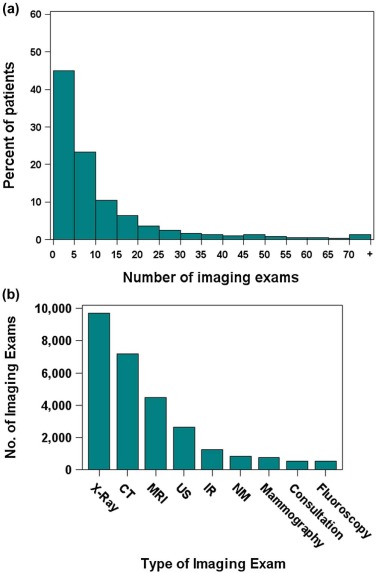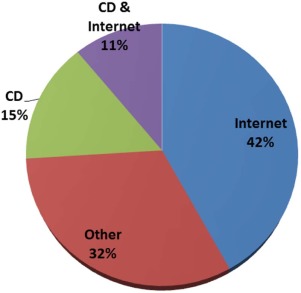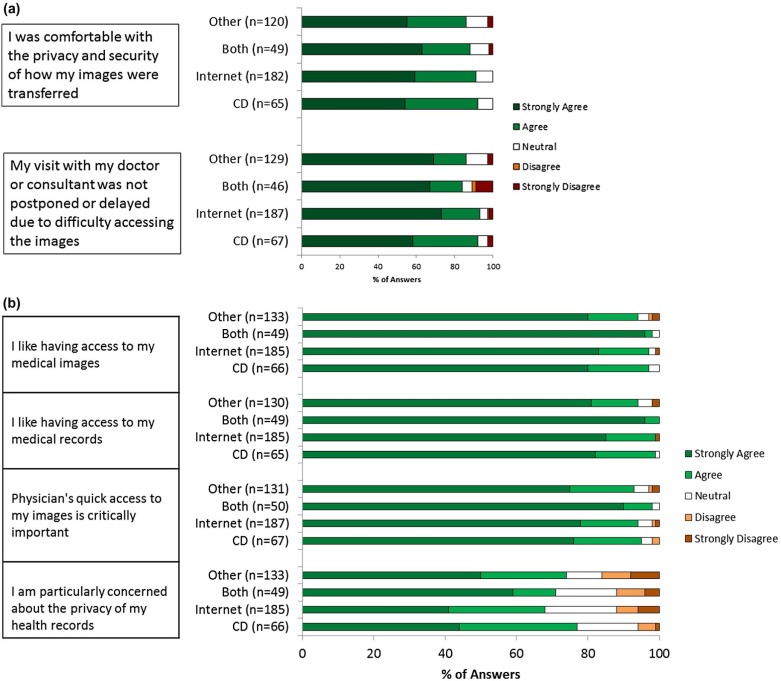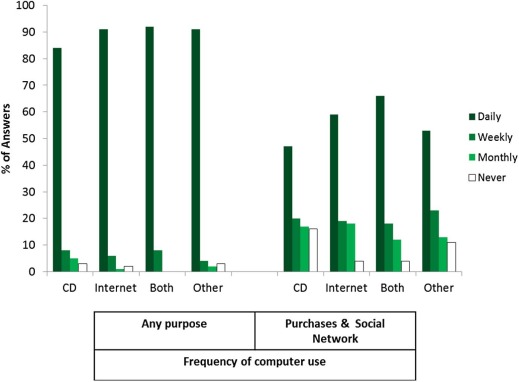Rationale and Objectives
Inefficient transfer of personal health records among providers negatively impacts quality of health care and increases cost. This multicenter study evaluates the implementation of the first Internet-based image-sharing system that gives patients ownership and control of their imaging exams, including assessment of patient satisfaction.
Materials and Methods
Patients receiving any medical imaging exams in four academic centers were eligible to have images uploaded into an online, Internet-based personal health record. Satisfaction surveys were provided during recruitment with questions on ease of use, privacy and security, and timeliness of access to images. Responses were rated on a five-point scale and compared using logistic regression and McNemar’s test.
Results
A total of 2562 patients enrolled from July 2012 to August 2013. The median number of imaging exams uploaded per patient was 5. Most commonly, exams were plain X-rays (34.7%), computed tomography (25.7%), and magnetic resonance imaging (16.1%). Of 502 (19.6%) patient surveys returned, 448 indicated the method of image sharing (Internet, compact discs [CDs], both, other). Nearly all patients (96.5%) responded favorably to having direct access to images, and 78% reported viewing their medical images independently. There was no difference between Internet and CD users in satisfaction with privacy and security and timeliness of access to medical images. A greater percentage of Internet users compared to CD users reported access without difficulty (88.3% vs. 77.5%, P < 0.0001).
Conclusion
A patient-directed, interoperable, Internet-based image-sharing system is feasible and surpasses the use of CDs with respect to accessibility of imaging exams while generating similar satisfaction with respect to privacy.
Introduction
Patients increasingly receive medical care from multiple providers, often in different practices, institutions, or geographic locations. In this complex healthcare delivery system, protected health information must be exchanged efficiently and in a manner that ensures its privacy and security, as mandated by the federal Health Insurance Portability and Accountability Act . Portable media, namely compact discs (CDs), are most commonly used to exchange medical images beyond the local environment. However, CDs may be misplaced or damaged, and data may be written in proprietary formats that the recipient is unable to access, often with image display software requiring administrative permission to install .
Several Internet-based systems for electronic sharing of medical images are now being employed . These new technologies must meet public expectations of seamless connectivity and privacy, as experienced with online banking, online shopping, and social networks, and must foster patient engagement and partnership with their providers. Currently, little evidence exists on the satisfaction of patients with technologies that pursue such goals in radiology .
Get Radiology Tree app to read full this article<
Materials and Methods
Setting
Get Radiology Tree app to read full this article<
Patient Enrollment
Get Radiology Tree app to read full this article<
Survey
Get Radiology Tree app to read full this article<
Analysis
Get Radiology Tree app to read full this article<
Get Radiology Tree app to read full this article<
Results
Characteristics of the Population
Get Radiology Tree app to read full this article<
Get Radiology Tree app to read full this article<
Get Radiology Tree app to read full this article<
Selection of Modality to Transfer and View Images
Get Radiology Tree app to read full this article<
Get Radiology Tree app to read full this article<
Get Radiology Tree app to read full this article<
Experience With Access
Get Radiology Tree app to read full this article<
Get Radiology Tree app to read full this article<
Experience With Sharing
Get Radiology Tree app to read full this article<
Table 1
Patient Answers to Survey Questions
Survey Question Agreement vs. All Others \* OR (95% CI)__\*\* Patient experience I was comfortable with the privacy and security CD 1.18 (0.41, 3.35) Both 0.68 (0.25, 1.83) Other 0.58 (0.28, 1.21) Visit was not delayed or postponed CD 0.84 (0.31, 2.27) Both 0.53 (0.19, 1.46) Other 0.50 (0.24, 1.04) Patient perspective I like having direct access to my exam images CD 0.72 (0.13, 4.02) Both 1.04 (0.11, 9.51) Other 0.35 (0.10, 1.17) I like having direct access to my medical records CD 0.36 (0.04, 3.51) Both 0.79 (0.03, 20.20) Other0.13 (0.02, 0.79) It was critically important that my doctor viewed my medical image quickly CD 0.93 (0.30, 2.88) Both 6.42 (0.36, 113.94) Other 0.83 (0.34, 2.04) In general, I am particularly concerned about maintaining the privacy of my health records CD 1.49 (0.79, 2.83) Both 1.26 (0.62, 2.56) Other 1.36 (0.83, 2.24)
Answers were grouped by modality of image sharing used by patients.
Get Radiology Tree app to read full this article<
Get Radiology Tree app to read full this article<
Get Radiology Tree app to read full this article<
Get Radiology Tree app to read full this article<
Get Radiology Tree app to read full this article<
History of Computer Use
Get Radiology Tree app to read full this article<
Get Radiology Tree app to read full this article<
Discussion
Get Radiology Tree app to read full this article<
Get Radiology Tree app to read full this article<
Get Radiology Tree app to read full this article<
Get Radiology Tree app to read full this article<
Get Radiology Tree app to read full this article<
Get Radiology Tree app to read full this article<
Study Limitations
Get Radiology Tree app to read full this article<
Conclusions
Get Radiology Tree app to read full this article<
Acknowledgments
Get Radiology Tree app to read full this article<
Get Radiology Tree app to read full this article<
Appendix
Supplementary material
Get Radiology Tree app to read full this article<
Appendix S1
Get Radiology Tree app to read full this article<
Get Radiology Tree app to read full this article<
Get Radiology Tree app to read full this article<
Appendix S2
Get Radiology Tree app to read full this article<
Get Radiology Tree app to read full this article<
References
1. Mendelson D.S., Bak P.R., Menschik E., et. al.: Informatics in radiology: image exchange: IHE and the evolution of image sharing. Radiographics 2008; 28: pp. 1817-1833. Epub 2008/09/06
2. Bodenheimer T.: Coordinating care—a perilous journey through the health care system. N Engl J Med 2008; 358: pp. 1064-1071. Epub 2008/03/07.
3. Kuperman G.J.: Health-information exchange: why are we doing it, and what are we doing?. J Am Med Inform Assoc 2011; 18: pp. 678-682. Epub 2011/06/17
4. Orszag P.R.: Evidence on the costs and benefits of health information technology. Statement of the Director of the Congressional Budget Office2008.
5. Ge Y., Ahn D.K., Unde B., et. al.: Patient-controlled sharing of medical imaging data across unaffiliated healthcare organizations. J Am Med Inform Assoc 2013; 20: pp. 157-163. Epub 2012/08/14
6. Hagiwara H., Nemoto A., Inoue T.: Burden on university hospitals of handling Portable Data for Imaging (PDI) media. Appl Clin Inform 2014; pp. 46-57.
7. Erickson B.J.: Experience with importation of electronic images into the medical record from physical media. J Digit Imaging 2011; 24: pp. 694-699. Epub 2011/02/03
8. Mendelson D.S., Rubin D.L.: Imaging informatics: essential tools for the delivery of imaging services. Academic radiology 2013; 20: pp. 1195-1212. Epub 2013/09/14
9. Kaelber D.C., Jha A.K., Johnston D., et. al.: A research agenda for personal health records (PHRs). J Am Med Inform Assoc 2008; 15: pp. 729-736. Epub 2008/08/30
10. Gadd C.S., Ho Y.-X., Cala C.M., et. al.: User perspectives on the usability of a regional health information exchange. J Am Med Inform Assoc 2011; 18: pp. 711-716.
11. Langer S.G., Tellis W., Carr C., et. al.: The RSNA image sharing network. J Digit Imaging 2014; 28: pp. 53-61. Epub 2014/07/20
12. Blumenthal D., Tavenner M.: The “meaningful use” regulation for electronic health records. N Engl J Med 2010; 363: pp. 501-504. Epub 2010/07/22
13. Flanders A.E.: Medical image and data sharing: are we there yet?. Radiographics 2009; 29: pp. 1247-1251. Epub 2009/09/17
14. Mandl K.D., Szolovits P., Kohane I.S.: Public standards and patients’ control: how to keep electronic medical records accessible but private. BMJ 2001; 322: pp. 283-287. Epub 2001/02/07
15. Johnson A.J., Frankel R.M., Williams L.S., et. al.: Patient access to radiology reports: what do physicians think?. J Am Coll Radiol 2010; 7: pp. 281-289. Epub 2010/04/07
16. Keselman A., Slaughter L., Smith C.A., et. al.: Towards consumer-friendly PHRs: patients’ experience with reviewing their health records. AMIA Ann Symp Proceed 2007; pp. 399-403. Epub 2008/08/13
17. Wen K.Y., Kreps G., Zhu F., et. al.: Consumers’ perceptions about and use of the internet for personal health records and health information exchange: analysis of the 2007 Health Information National Trends Survey. J Med Internet Res 2010; 12: pp. e73. Epub 2010/12/21
18. Tang P.C., Lansky D.: The missing link: bridging the patient-provider health information gap. Health Aff (Millwood) 2005; 24: pp. 1290-1295. Epub 2005/09/16
19. Johnson A.J., Easterling D., Williams L.S., et. al.: Insight from patients for radiologists: improving our reporting systems. J Am Coll Radiol 2009; 6: pp. 786-794. Epub 2009/11/03
20. Ball M.J., Costin M.Y., Lehmann C.: The personal health record: consumers banking on their health. Stud Health Technol Inform 2008; 134: pp. 35-46. Epub 2008/04/01
21. Delbanco T., Berwick D.M., Boufford J.I., et. al.: Healthcare in a land called PeoplePower: nothing about me without me. Health Expect 2001; 4: pp. 144-150. Epub 2001/08/09
22. Whiddett R., Hunter I., Engelbrecht J., et. al.: Patients’ attitudes towards sharing their health information. Int J Med Inform 2006; 75: pp. 530-541. Epub 2005/10/04
23. Tang P.C., Ash J.S., Bates D.W., et. al.: Personal health records: definitions, benefits, and strategies for overcoming barriers to adoption. J Am Med Inform Assoc 2006; 13: pp. 121-126. Epub 2005/12/17
24. Yamin C.K., Emani S., Williams D.H., et. al.: The digital divide in adoption and use of a personal health record. Arch Intern Med 2011; 171: pp. 568-574. Epub 2011/03/30
25. Wyatt E.: Most of U.S. is wired, but millions aren’t plugged in.2013. 2013 August 19





